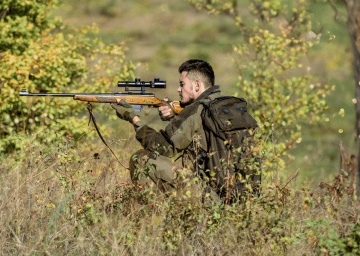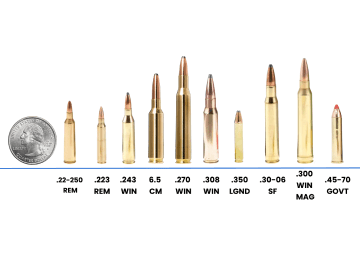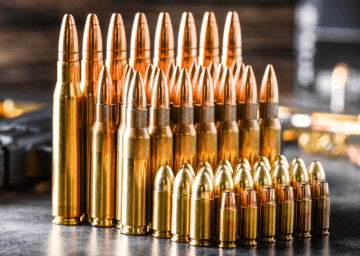Rifle Calibers Compared: Choose the Right Ammo for Your Hunt

Whether you're a seasoned hunter or a newcomer to the sport, knowing the differences between rifle calibers will help elevate your shooting experience and achieve your hunting goals. From the swift and precise varmint calibers to the mighty giants designed for big game, we will help you get the most out of a hunting rifle.
Key Takeaways
- What Is Caliber? Caliber refers to the barrel diameter, so a higher caliber means a bigger bullet. The cartridge is made of the bullet, cartridge case, propellant, rim, and primer.
- Find the Right Ammo for Your Rifle: Use ammo with thin jackets and soft cores for varmint hunting. For medium game or deer hunting, use soft-point bullets. For large game, get bullets with thick, tapered jackets bonded to the core.
- Bullet Construction for Different Game Sizes: For varmint hunting, go with .223, .243, or .22 ammo. For medium game .308, .30-06, .270, .243, and 6.5mm are great options. For large and dangerous game, we recommend .308, .30-06, .300, 6.5mm, and 7mm.
- Rifle Cartridge & Caliber Comparison Chart: Compare the bullet weight, distance, and usage for our top 10 recommended types of rifle ammunition.
What Is Caliber?

Understanding the terminology and specifics behind firearms and ammunition is crucial for all shooters. Getting the essentials down will help you make informed decisions when shopping for the best ammunition or rifle.
Caliber Basics
Let’s start with the basics. Although people commonly use the term to refer to the bullet width, ‘caliber’ refers to the gun barrel’s diameter. In other words, a higher caliber means a bigger bullet. A bigger bullet means being able to hunt larger game.
How Are Cartridges Different?
Meanwhile, a ‘cartridge’ is one unit of ammunition. Also called a ‘round,’ it consists of the bullet, cartridge case, propellant (like gunpowder), rim, and primer.
Why Using the Correct Cartridge Is Important
Not all cartridges are made the same, so it’s important to find the right one for your rifle. Using the exact cartridge specified on your rifle’s barrel and receiver is essential for safety and keeping your rifle in working condition. Using the incorrect cartridge can cause serious injuries or rifle damage.
Expert Tip:
Never mismatch your ammo and gun. For example, for a .300 Win WSM rifle, you should only use .300 Win WSM rounds. While it’s tempting to use cheaper .300 variants, you should stick to what is noted on your firearm.
Caliber and Recoil
Recoil refers to the backward movement of a firearm upon firing. Generally, larger calibers produce more recoil than smaller calibers. This is because larger calibers typically have heavier bullets and greater powder charges, resulting in increased energy transferred to the shooter upon firing.
Find the Right Ammo for Your Rifle

Choosing the correct ammunition is critical to ensuring your firearm's performance and safety. Understanding different types of bullets and bullet characteristics can significantly enhance your shooting experience and success in the field.
Bullet Styles
Not all cartridges are the same, and the same goes for bullets. For example, if you have a lever action rifle with a tubular magazine, you should use flat-nose bullets to avoid accidental detonation. However, most bullets have pointed or ‘spitzer’ tips.
Spitzer tips enhance ballistic efficiency, except for ‘heavy for caliber’ bullets which are less stable and designed for short-range encounters.
Bullets have different advantages depending on what game you are hunting. For varmint hunting, you should use bullets with thin jackets and soft cores for rapid expansion. If you’re hunting large game, opt for bullets with thicker or tapered jackets bonded to the core.
Use bullets with softer points if you’re hunting deer or a similar-sized game. These bullets are suitable for animals with thinner hides.
Ammunition Grade
When it comes to ammunition grade, you get what you pay for. Premium-grade ammo is more expensive, however, it offers better quality through superior components such as the casing, bullets, powders, and primers.
Premium-grade ammo is manufactured under strict specifications and tighter quality control for improved accuracy and consistency. This ammo is a worthwhile investment for big game hunting, given the lower annual usage.
Twist Rate
When selecting ammunition, you should consider twist rate. Bullet twist rate refers to the rate of spin imparted on a bullet by the rifling inside a firearm's barrel, measured in inches per turn. This spin stabilizes the bullet's flight to improve accuracy and consistency. Using bullets with the wrong twist rates can lead to shooting inaccuracies and lower firearm performance overall.
When selecting a twist rate for rifles, consider the bullet weight and length you plan to use most frequently. Heavier and longer bullets typically require a faster twist rate (such as 1:7”) to stabilize properly, while lighter, shorter bullets may perform better with a slower twist rate (like 1:10” or 1:11”).
Bullet Weight
A bullet’s weight is a major factor in determining its performance and effectiveness. Heavier bullets typically carry more momentum, which results in greater terminal ballistic performance for big game hunting. Conversely, lighter bullets may offer higher velocities and flatter trajectories, making them more suitable for long-range shooting or varmint hunting.
Ballistic Coefficient (BC)
The ballistic coefficient (BC) is a measure of a bullet’s ability to overcome air resistance in flight. Understanding the BC of a bullet is crucial for accurately predicting its flight path.
A higher BC indicates better aerodynamic efficiency, resulting in flatter trajectories, less wind drift, and retained velocity downrange. A lower BC, on the other hand, indicates that a bullet is less aerodynamically efficient, meaning it experiences greater air resistance during flight. Bullets with lower BC values tend to have steeper trajectories, lose velocity more rapidly, and are more susceptible to wind drift.
Terminal Performance
Terminal performance refers to a bullet’s behavior upon impact with a target, including its ability to enter, expand, and transfer energy. Optimal terminal performance transfers the correct amount of energy to the game and ensures an ethical kill. Knowing terminal performance characteristics helps you select ammo tailored to your needs and ensure the desired outcome.
Expert Tip:
When hunting game meat, you want just enough bullet expansion to create stopping power while avoiding overpenetration and fragmentation.
Specialty Ammo
Today’s market offers a broad selection of high-quality factory ammunition tailored to various hunting needs and preferences. Reduced recoil loads are ideal for shooters sensitive to recoil. They provide effective performance on deer-sized game up to 200 yards with significantly less felt recoil.
Hyper-velocity loads are ideal for those who do not mind higher recoil and seek maximum performance. High-velocity loads offer faster velocities, flatter trajectories, and more energy.
Lead-free bullets are becoming more popular for legal and health reasons, such as in certain hunting areas or those concerned about lead in venison.
Bullet Construction for Different Game Sizes

Bullets are designed to achieve a delicate balance between depth and expansion upon impact. This balance is crucial because it determines the bullet's ability to cause sufficient internal damage to ensure a quick and humane kill. Academy’s website has a full selection of ammunition organized by gauge and caliber.
Varmint and Small Game
Bullets for varmint and small game typically feature thin jackets and soft cores. The rationale behind this design is to ensure rapid expansion upon impact. The most common calibers used in this scenario are .223, .243, and .22.
Small game and varmints are small and have thin hides. For this reason, the bullet needs to expand quickly to avoid overpenetration and ensure the animal is dispatched humanely.
Examples of small game and varmints include rabbits, squirrels, and groundhogs. The quick expansion reduces the bullet's likelihood of passing through and damaging surrounding areas.
Medium Game
When hunting medium-sized game, such as deer or antelope, opt for bullets that balance depth and controlled expansion. Look for designs featuring slightly thicker jackets and harder cores compared to varmint bullets. The most common calibers used for hunting medium game are .308, .30-06, .270, .243, and 6.5mm.
This construction ensures the bullet reaches vital organs and expands enough to create significant stopping power. Soft point bullets are a popular choice for hunting medium game, since full metal jacket (FMJ) bullets are notorious for overpenetration.
Large and Dangerous Game
Bears, moose, or African big game require bullets with thicker, tapered jackets and often feature bonded cores or solid construction. These bullets can get through thick hides, dense muscle tissue, and even animal bone. The calibers we recommend for hunting large game are .308, .30-06, .300, 6.5mm, and 7mm.
The bullet must retain its mass and shape as much as possible upon impact to take down this type of game and ensure your safety. Controlled expansion bullets, solid copper bullets, and other designs with minimal expansion are preferred.
Expert Tip:
In addition to the caliber, choose a sufficient bullet weight (measured in grains) based on the size of your hunting game and the distance from which you’re shooting.
Rifle Cartridge & Caliber Comparison Chart
Check out this comparison chart to learn the differences between our most recommended rifle ammunition. Compare the caliber, weight, distance, and usage to determine which is the best for your hunting preferences.
| Rifle Cartridge & Caliber Comparison Chart | ||||
|---|---|---|---|---|
| Cartridge | Caliber | Bullet Weight (Grains) | Distance | Usage |
|
.22-250 Remington |
.22 |
35-55 |
Short to mid-range |
Small rodents, mammals, and birds |
|
.223 Remington |
.223 |
40-77 |
Short range |
Boar and small mammals |
|
.243 Winchester |
.243 |
55-115 |
Mid-range |
Small mammals, deer, antelope, caribou, and boar |
|
6.5 Creedmoor |
6.5 |
120-147 |
Long-range |
Deer, antelope, caribou, and boar |
|
.270 Winchester |
.270 |
90-160 |
Mid to long-range |
Deer, antelope, caribou, and boar |
|
.308 Winchester |
.308 |
150-180 |
Short to mid-range |
Deer, antelope, caribou, boar, bear, moose, and elk |
|
.350 Legend |
.350 |
145-180 |
Short to mid-range |
Firing in dense forest or brush |
|
.30-06 Springfield |
.30-06 |
150-220 |
Mid-range |
Small mammals, deer, antelope, caribou, boar, bear, moose, and elk |
|
.300 Winchester Magnum |
.300 |
150-250 |
Long-range |
Deer, antelope, caribou, boar, bear, moose, and elk |
|
.45-70 |
.45-70 |
300-500 |
Short to mid-range |
Firing in dense forest or brush |
Choose the Best Bullet

Choosing the best bullet for your hunting needs involves understanding the game you intend to pursue and the performance characteristics of different bullet constructions. Begin by considering the size and toughness of your intended game.
You should also consider the cost and availability of your chosen ammunition. The cheaper and more readily available the bullets, the easier it will be for you to hunt regularly.
Additionally, factor in your firearm's specifications and the shooting distance, as these will influence the ideal bullet choice. You'll enhance your success and ethical hunting practices by aligning bullet design with your hunting objectives and environmental conditions.
Have Fun Out There!
It's time to get the most out of your hunting experience. Explore Academy Sports + Outdoors’ diverse selection of rifle ammunition today and find the perfect match for your hunting needs. Whether you're targeting varmint, deer, or defending against dangerous game, our extensive range caters to every hunter's preference and rifle specifications.


